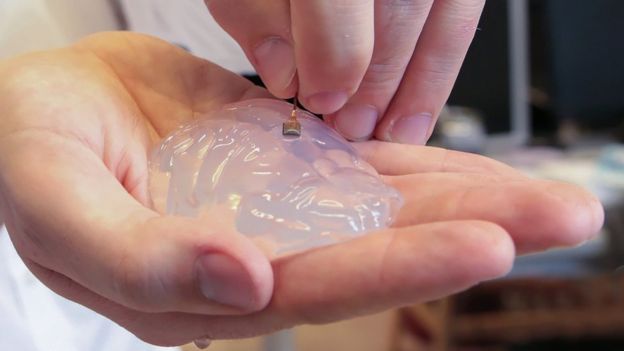For the first time in history, a new brain chip was able to restore leg movement in paralyzed primates – a difficult feat that experts suggest could be conducted in human trials in about 10 years.
Within six days of implanting the brain-spine interface, monkeys with one paralyzed leg regained leg movement, and were able to walk on a treadmill, according to a study published in Nature.
This chip was tested in collaboration with the University of Bordeaux, Motac Neuroscience in France and the Lausanne University Hospital in Switzerland. Its development falls under a collaboration between Medtronic, Brown University and Fraunhofer ICT-IMM.

How the Chip Works
The chip – which contains recording electrodes – is implanted in the brain, in the area of the motor cortex that regulates leg movement. The device then records the spiking electrical activity, and the information is sent to a computer.
“To implement the brain-spine interface, we developed an implantable, wireless system that operates in real-time and enabled a primate to behave freely, without the constraint of tethered electronics,” says neuroscientist Grégoire Courtine, International Paraplegic Foundation (IRP) chair in spinal cord repair. “We understood how to extract brain signals that encode flexion and extension movements of the leg with a mathematical algorithm. We then linked the decoded signals to the stimulation of specific hotspots in the spinal cord that induced the walking movement.”
The brain-spine interface then decodes the signals and transmits the information to an implant in the monkey’s spine, where the signals are reproduced through epidural electrical stimulation (EES).
In other words, an artificial connection between the brain and legs is established, enabling the appropriate leg muscles to be activated through electrical stimulation.
Courtine says the movement was close to normal for the basic walking pattern, but the ability to steer has yet to be tested.
“The primate was able to walk immediately once the brain-spine interface was activated. No physiotherapy or training was necessary,” says neuroscientist Erwan Bezard of Bordeaux University, who led the experiments.

What are the Challenges of the Brain Chip?
The framework of this study hinges on recent studies of paralyzed rats and the link between EES and spinal circuits. Researchers say they plucked this knowledge to streamline stimulations protocols for clinical trials.
“This is the first time that neurotechnology restores locomotion in primates,” says Courtine. “But there are many challenges ahead and it may take several years before all the components of this intervention can be tested in people.”
For example, as humans are bipedal, the way they walk is different, which would require more sophisticated ways to stimulate the muscle.
Although many challenges may lie ahead for future clinical demonstrations of the interface, Dr. Mark Bacon, director of research at the charity Spinal Research says “current work is a clear demonstration that there is progress being made in the right direction.”
“The link between the decoding of the brain and the stimulation of the spinal cord – to make this communication exist – is completely new,” says neurosurgeon Jocelyne Bloch who leads the functional neurosurgery department at the Lausanne University Hospital.
“For the first time, I can imagine a completely paralyzed patient able to move their legs through this brain-spine interface,” she says.

